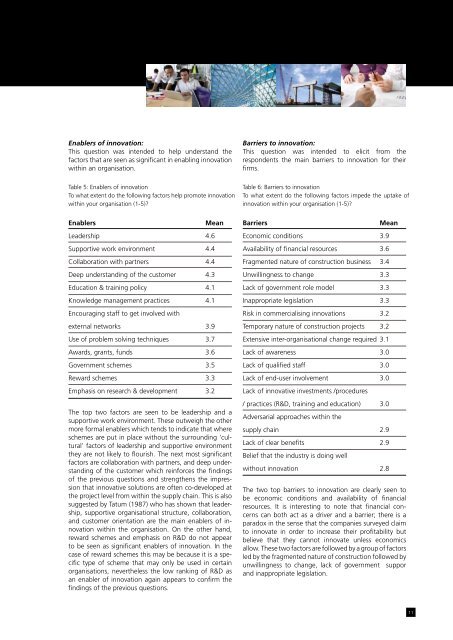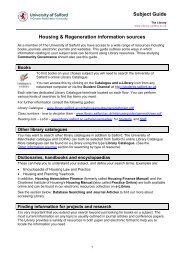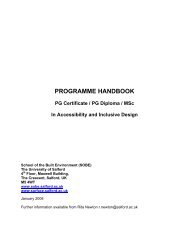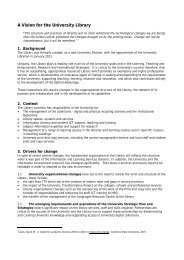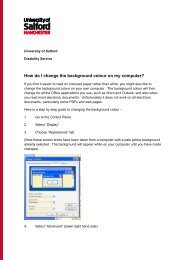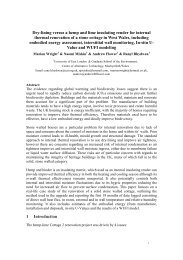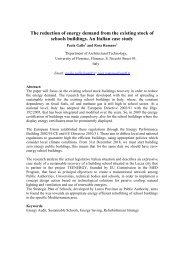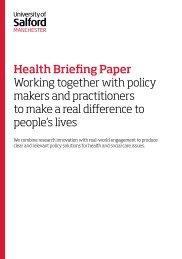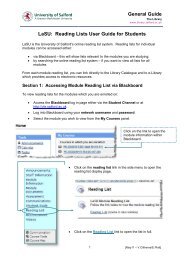Innovation in Construction A Project Life Cycle Approach
Innovation in Construction A Project Life Cycle Approach
Innovation in Construction A Project Life Cycle Approach
You also want an ePaper? Increase the reach of your titles
YUMPU automatically turns print PDFs into web optimized ePapers that Google loves.
Enablers of <strong>in</strong>novation:This question was <strong>in</strong>tended to help understand thefactors that are seen as significant <strong>in</strong> enabl<strong>in</strong>g <strong>in</strong>novationwith<strong>in</strong> an organisation.Barriers to <strong>in</strong>novation:This question was <strong>in</strong>tended to elicit from therespondents the ma<strong>in</strong> barriers to <strong>in</strong>novation for theirfirms.Table 5: Enablers of <strong>in</strong>novationTo what extent do the follow<strong>in</strong>g factors help promote <strong>in</strong>novationwith<strong>in</strong> your organisation (1-5)?Table 6: Barriers to <strong>in</strong>novationTo what extent do the follow<strong>in</strong>g factors impede the uptake of<strong>in</strong>novation with<strong>in</strong> your organisation (1-5)?EnablersMeanLeadership 4.6Supportive work environment 4.4Collaboration with partners 4.4Deep understand<strong>in</strong>g of the customer 4.3Education & tra<strong>in</strong><strong>in</strong>g policy 4.1Knowledge management practices 4.1Encourag<strong>in</strong>g staff to get <strong>in</strong>volved withexternal networks 3.9Use of problem solv<strong>in</strong>g techniques 3.7Awards, grants, funds 3.6Government schemes 3.5Reward schemes 3.3Emphasis on research & development 3.2The top two factors are seen to be leadership and asupportive work environment. These outweigh the othermore formal enablers which tends to <strong>in</strong>dicate that whereschemes are put <strong>in</strong> place without the surround<strong>in</strong>g ‘cultural’factors of leadership and supportive environmentthey are not likely to flourish. The next most significantfactors are collaboration with partners, and deep understand<strong>in</strong>gof the customer which re<strong>in</strong>forces the f<strong>in</strong>d<strong>in</strong>gsof the previous questions and strengthens the impressionthat <strong>in</strong>novative solutions are often co-developed atthe project level from with<strong>in</strong> the supply cha<strong>in</strong>. This is alsosuggested by Tatum (1987) who has shown that leadership,supportive organisational structure, collaboration,and customer orientation are the ma<strong>in</strong> enablers of <strong>in</strong>novationwith<strong>in</strong> the organisation. On the other hand,reward schemes and emphasis on R&D do not appearto be seen as significant enablers of <strong>in</strong>novation. In thecase of reward schemes this may be because it is a specifictype of scheme that may only be used <strong>in</strong> certa<strong>in</strong>organisations, nevertheless the low rank<strong>in</strong>g of R&D asan enabler of <strong>in</strong>novation aga<strong>in</strong> appears to confirm thef<strong>in</strong>d<strong>in</strong>gs of the previous questions.BarriersMeanEconomic conditions 3.9Availability of f<strong>in</strong>ancial resources 3.6Fragmented nature of construction bus<strong>in</strong>ess 3.4Unwill<strong>in</strong>gness to change 3.3Lack of government role model 3.3Inappropriate legislation 3.3Risk <strong>in</strong> commercialis<strong>in</strong>g <strong>in</strong>novations 3.2Temporary nature of construction projects 3.2Extensive <strong>in</strong>ter-organisational change required 3.1Lack of awareness 3.0Lack of qualified staff 3.0Lack of end-user <strong>in</strong>volvement 3.0Lack of <strong>in</strong>novative <strong>in</strong>vestments /procedures/ practices (R&D, tra<strong>in</strong><strong>in</strong>g and education) 3.0Adversarial approaches with<strong>in</strong> thesupply cha<strong>in</strong> 2.9Lack of clear benefits 2.9Belief that the <strong>in</strong>dustry is do<strong>in</strong>g wellwithout <strong>in</strong>novation 2.8The two top barriers to <strong>in</strong>novation are clearly seen tobe economic conditions and availability of f<strong>in</strong>ancialresources. It is <strong>in</strong>terest<strong>in</strong>g to note that f<strong>in</strong>ancial concernscan both act as a driver and a barrier; there is aparadox <strong>in</strong> the sense that the companies surveyed claimto <strong>in</strong>novate <strong>in</strong> order to <strong>in</strong>crease their profitability butbelieve that they cannot <strong>in</strong>novate unless economicsallow. These two factors are followed by a group of factorsled by the fragmented nature of construction followed byunwill<strong>in</strong>gness to change, lack of government supporand <strong>in</strong>appropriate legislation.11


